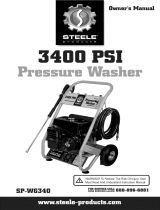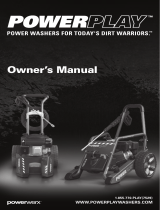
16
Owner’s Manual
Limited Warranty
Pulsar Products, Inc. warrants to the original purchaser who uses the product in a
consumer application (personal, residential or household usage) that all products
covered under this warranty are free from defects in material and workmanship for one
year from the date of purchase. All products covered by this limited warranty which are
used in commercial applications (i.e. income producing) are warranted to be free of
defects in material and workmanship for 90 days from the date of original purchase.
Products covered under this warranty include air compressors, air tools, service parts,
pressure washers and generators.
Pulsar Products, Inc. will repair or replace, at Pulsar Products, Inc.’s sole option,
products or components which have failed within the warranty period. Service will be
scheduled according to the normal work flow and business hours at the service center
location, and the availability of replacement parts. All decisions of Pulsar Products, Inc.
with regard to this limited warranty shall be final.
This warranty gives you specific legal rights, and you may also have other rights which
vary from state to state.
RESPONSIBILITY OF ORIGINAL PURCHASER (initial User):
To process a warranty claim on this product, DO NOT return item to the retailer. The
product must be evaluated by an Authorized Warranty Service Center. For the location
of the nearest Authorized Warranty Service Center contact the retailer or place of
purchase.
Retain your original cas sales receipt as proof of purchase for all
warranty work.
Use reasonable care in the operation and maintenance of the product as described in
the Owner’s Manual(s).
Deliver or ship the product to the Authorized Warranty Service Center. Freight costs, if
any must be paid by the purchaser.
If the purchaser does not receive satisfactory results form the Authorized Warranty
Service Center, the purchaser should contact Pulsar Products, Inc. .
17
Owner’s Manual
Limited Warranty (cont’d)
THIS WARRANTY DOES NOT COVER:
0HUFKDQGLVHVROGDVUHFRQGLWLRQHGXVHGaVUHQWDOHTXLSPHQWRUIORRURUGLVSOD\
PRGHOV
0HUFKDQGLVHWKDWKDVEHFRPHGDPDJHGRrLQRSHUDWLYHEHFDXVHRIRUGLQDU\ZHDU
PLVXVHFROGKHDWUDLQH[FHVVLYHKXPLGLWyIUHH]HGDPDJHXVHRILPSURSHU
FKHPLFDOVQHJOLJHQFHDFFLGHQWIDLOXUHWRoSHUDWHWKHSURGXFWLQDFFRUGDQFHZLWKWKH
LQVWUXFWLRQVSURYLGHGLQWKH2ZQHU¶V0DQXaOVVXSSOLHGZLWKWKHSURGXFWLPSURSHU
PDLQWHQDQFHWKHXVHRIDFFHVVRULHVRUDWWDFKPHQWVQRWUHFRPPHQGHGE\3XOVDU
3URGXFWV,QFRUXQDXWKRUL]HGUHSDLURUDOWHUDWLRQV
5HSDLUDQGWUDQVSRUWDWLRQFRVWVRIPHUFKDQGLVHGHWHUPLQHGQRWWREHGHIHFWLYH
&RVWVDVVRFLDWHGZLWKDVVHPEO\UHTXLUHG RLODGMXVWPHQWVRURWKHULQVWDOODWLRQDQG
VWDUWXSFRVWV
([SHQGDEOHSDUWVRUDFFHVVRULHVVXSSOLHdZLWKWKHSURGXFWZKLFKDUHH[SHFWHGWR
EHFRPHLQRSHUDWLYHRUXQXVDEOHDIWHUDUHaVRQDEOHSHULRGRIXVH
0HUFKDQGLVHVROGE\3XOVDU3URGXFWV,QFZKLFKKDVEHHQPDQXIDFWXUHGE\
DQGLGHQWLILHGDVWKHSURGXFWRIDQRWKHUFRPSDQ\VXFKDVJDVROLQHHQJLQHV7KH
SURGXFWPDQXIDFWXUHU¶VZDUUDQW\LIDQ\ZLOODSSO\
$1<,1&,'(17$/,1',5(&725&216(48(17,$//266'$0$*(25
(;3(16(7+$70$<5(68/7)520$N<'()(&76)$,/85(25
0$/)81&7,212)7+(352'8&7,6N27&29(5('%<7+,6:$55$17<
6RPHVWDWHVGRQRWDOORZWKLVH[FOXVLRQVRLWPD\QRWDSSO\WR\RX
,03/,(':$55$17,(6,1&/8',1*7+26(2)0(5&+$17$%,/,7<25
),71(66)25$3$57,&8/$5385326($5(/,0,7('7221(<($5)520
7+('$7(2)25,*,1$/385&+$6(6RPHVWDWHVGRQRWDOORZOLPLWDWLRQVRQKRZ
ORQJDQLPSOLHGZDUUDQW\ODVWVVRWKHDERYHOLPLWDWLRQVPD\QRWDSSO\WR\RX


















